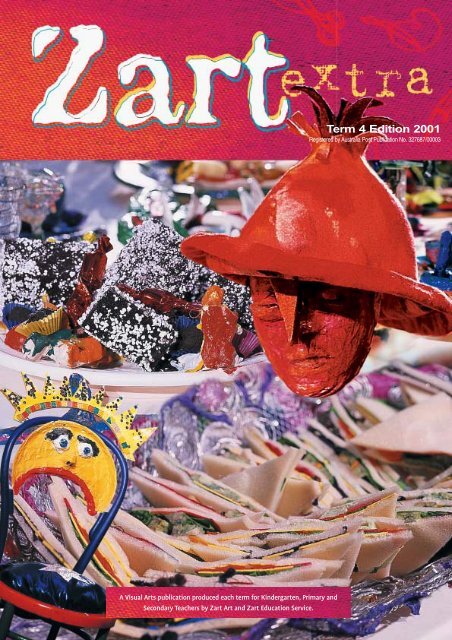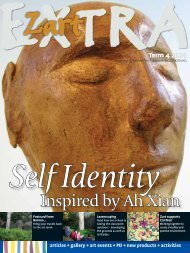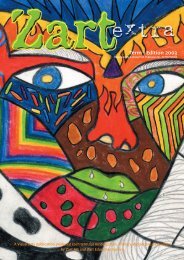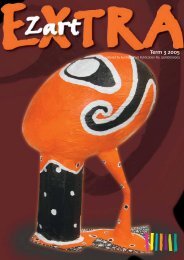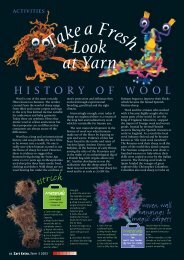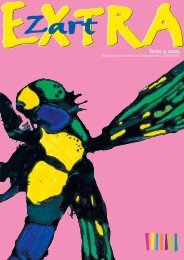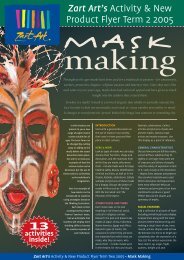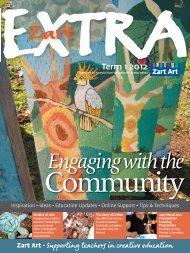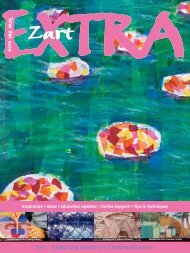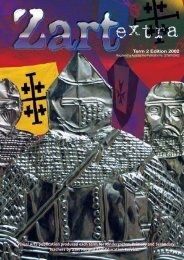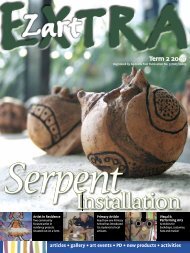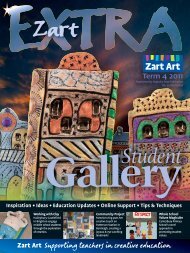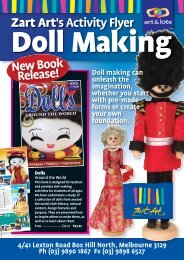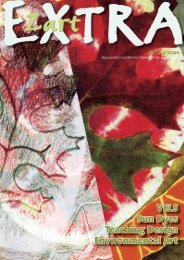Term 4 Edition 2001 - Zart Art
Term 4 Edition 2001 - Zart Art
Term 4 Edition 2001 - Zart Art
Create successful ePaper yourself
Turn your PDF publications into a flip-book with our unique Google optimized e-Paper software.
A Visual <strong>Art</strong>s publication produced each term for Kindergarten, Primary and<br />
Secondary Teachers by <strong>Zart</strong> <strong>Art</strong> and <strong>Zart</strong> Education Service.<br />
<strong>Term</strong> 4 <strong>Edition</strong> <strong>2001</strong><br />
Registered by Australia Post Publication No. 327687/00003
Front Cover:<br />
‘Dinner Party’<br />
Caulfield Grammar Malvern Campus<br />
<strong>Zart</strong> <strong>Art</strong><br />
PO Box 1136<br />
Box Hill Vic Australia 3128<br />
4/41 Lexton Road<br />
Box Hill North Vic 3129<br />
Ph: (03) 9890 1867<br />
Fax: (03) 9898 6527<br />
Internet: www.zartart.com.au<br />
Email: zartart@zartart.com.au<br />
Hours:<br />
8.30am-5.00pm Weekdays<br />
8.30am-12.00 noon Saturday<br />
<strong>Zart</strong>works<br />
Po Box 1136<br />
Box Hill Vic Australia 3128<br />
3/41 Lexton Road<br />
Box Hill North Vic 3129<br />
Ph: (03) 9890 5110<br />
Fax: (03) 9898 6527<br />
Internet: www.zartart.com.au<br />
email: zartart@zartart.com.au<br />
Hours:<br />
9.00am-5.00pm Weekdays<br />
9.00am-12.00 noon Saturday<br />
<strong>Zart</strong> <strong>Art</strong> School &<br />
Wholesale Supplier<br />
<strong>Zart</strong> <strong>Art</strong> offers an extensive range of resources, art<br />
materials, craft and technology supplies. You will<br />
find competitive prices and efficient and quick<br />
service.<br />
<strong>Zart</strong>works Retail Shop<br />
<strong>Zart</strong>works have all your art and craft needs<br />
catering for both beginner and professional<br />
artists. You can select from a wide range of visual<br />
arts, craft and graphic supplies. Browse at your<br />
leisure or seek assistance from our experienced<br />
staff.<br />
<strong>Zart</strong> Children’s Gallery<br />
The gallery features art works made by children<br />
from Prep to Year 12, from all around Victoria.<br />
Schools can arrange for children to visit the gallery,<br />
analyse the works of their contemporaries and<br />
then make a relevant piece of their own art work<br />
in our workshops with an art consultant. The<br />
gallery is also open to the public for viewing,<br />
during opening hours free of charge.<br />
<strong>Zart</strong> Education Service<br />
<strong>Zart</strong> Education Service provides hands on<br />
professional development workshops for Primary<br />
and Secondary teachers, as well as Kindergarten,<br />
LOTE teachers and Librarians. Visual <strong>Art</strong>s<br />
workshops are regularly held at <strong>Zart</strong> and upon<br />
request at your school, district or KLA’s group.<br />
<strong>Art</strong> Homework<br />
New homework guidelines for Victorian schools were released earlier this year by DEET<br />
(Department of Education, Employment and Training). The guidelines for Prep – Year 10 are<br />
structured to provide a gradual increase in the breadth and depth of homework as<br />
students move up the education ladder. What are the implications for the visual arts, if<br />
any? That would depend on the school’s perception of art education.<br />
We believe the art programme should be practical, relaxing and fun, and it should provide<br />
the development of new skills and the means for creativity and self expression. We are<br />
educating students to become life long learners, explorers and communicators, as well as<br />
appreciators of the arts.<br />
So what about homework? Can it be justified? Yes, if the art homework enriches and<br />
extends the art programme, we believe there is a place for it from upper primary level<br />
onwards where students are more independent learners and more proficient in their<br />
language and research skills.<br />
Little people should be too busy playing, spontaneously engaging in art activities and<br />
deepening and broadening their awareness of themselves and their world. Homework<br />
would impede this vital process.<br />
<strong>Art</strong> homework tasks may be in a simple and practical form eg. students are given a<br />
starting point and asked to complete the drawing (using the limited drawing tools<br />
available in the home). Sketching of familiar objects is also an achievable home activity.<br />
The ‘creative juices’ can flow in a more familiar environment and not relegated just to the<br />
art room.<br />
Another quest of exploration introduces students to their culture. Teachers may<br />
recommend current national, regional and community gallery exhibitions to students and<br />
their parents. This is often a simple notice in the school newsletter. Students should be<br />
encouraged to draw inspiration from looking at the works of other artists, attending<br />
movies, collecting ‘things’ from nature and generally being ‘aware’ of the world around<br />
them.<br />
A more popular form of art homework exposes students to art history. More specifically,<br />
they may be asked to research a particular artist or art period. These exercises may be used<br />
to attune students with the aesthetic qualities of specific artists and eras. They often<br />
provide inspiration and influence for students’ own art works.<br />
We live in the knowledge age. Accessing information is achievable by pressing a button<br />
but knowing what to do with the information is far more challenging. It is pointless to<br />
find out about Van Gogh’s chopped ear and not understand his intensity and use of colour<br />
to create emotionally charged effects. It is a waste of time to know when Paul Klee was<br />
born but not appreciate his sensitivity and insight into our inner beings.<br />
Teaching thinking and creativity is a way of managing the vast amount of information<br />
available to us today. New economies trade not in ‘things’ but in ideas and innovations. It<br />
is the way of the world.<br />
<strong>Art</strong> homework in art can be enriching…… if it is selective, relevant and an extension of the<br />
thinking and creativity found in the art room.<br />
“Our World in the Year 2000, is a splendid example of how the universal<br />
language of art can cross boundaries and barriers, bringing nations<br />
together to promote greater understanding among peoples and<br />
cultures”.<br />
Kofi Annan, Secretary- General of the United Nations.<br />
<strong>Zart</strong> Education Service<br />
Page 2<br />
<strong>Zart</strong> extra<br />
<strong>Term</strong> 4 <strong>2001</strong> <strong>Edition</strong>
Primary <strong>Art</strong>icle<br />
DINNER PARTY<br />
CAULFIELD GRAMMAR MALVERN CAMPUS<br />
“There are not enough words to describe the<br />
‘Dinner Party Exhibition’ created by children from<br />
Preparatory through to Year six at Caulfield<br />
Grammar School.” The statement was made<br />
by one person after another after<br />
experiencing this installation. I say<br />
“experience” because of the subtle<br />
movement of the guests and the taped<br />
conversations heard.<br />
Last year working with Catherine O’Leary, a textile<br />
artist, the children from Kindergarten to Year six created<br />
an organic hanging incorporating silk paper, painting and<br />
felt work. From here we wondered where to go …..hats? The<br />
Mad Hatter’s Tea Party? No, it’s been done<br />
before. What about a dinner<br />
party? Could primary aged<br />
children understand this<br />
concept? Maybe a “Cool<br />
Kids Café” would be<br />
more appropriate? Work<br />
began on the theme, with<br />
flexibility depending on how<br />
the children felt!<br />
Catherine, Heather Redher ( a book illustrator) and I met<br />
and correlated our ideas. Lists of work to be created,<br />
materials required and a rough time schedule were formed.<br />
We met regularly to assess and plan as it was our belief<br />
that although we formed the original structure, the<br />
students were to own it. This meant constant changes as<br />
their ideas flowed.<br />
Brainstorming was the first activity so we could decide on<br />
our twelve themes for the chairs and table setting. Each<br />
class was allocated a task which also provided an<br />
introduction to a new medium and / or process. Classes<br />
from Year 2 to 6 worked on designs based on these chosen<br />
themes. One Year 6 class worked in small groups exploring<br />
felt making to create hats. They were given plastic<br />
blocking shapes and from here they<br />
chose their colours and final<br />
hat shape. I was pleasantly<br />
surprised at their consistency<br />
and patience with this lengthy<br />
process.<br />
Another ceramist was employed for a<br />
day to work with Year 6 on extruded coils<br />
to form candelabra. Catherine and I<br />
made the decision to create a change of<br />
colour to contrast with the rest of<br />
the installation. A lesson in tone<br />
was the result.<br />
The second Year 6 class worked in<br />
groups of two or three to create<br />
their thematical chair.<br />
Encouragement was offered to<br />
add changes to the structures<br />
before beginning the decorative<br />
process from a free range of<br />
materials. This was a valuable lesson<br />
in group dynamics, negotiating<br />
changes, allocation of tasks and<br />
finally the decision of who<br />
takes final possession of the<br />
artwork.<br />
Year 5 students explored the<br />
creation of masks by placing silk<br />
threads over plastic masks and<br />
highlighting the features with pastel. The other class<br />
<strong>Zart</strong> extra<br />
<strong>Term</strong> 4 <strong>2001</strong> <strong>Edition</strong><br />
Page 3
Primary <strong>Art</strong>icle cont.<br />
explored hand<br />
moulding. Here<br />
various techniques<br />
were experienced, a glove full of<br />
water was frozen and the glove<br />
removed, wireform was then<br />
moulded over the frozen hand,<br />
they also poured plaster into sewn<br />
fabric shapes and gloves.<br />
One Year 4 class worked with a<br />
great technique to create cutlery.<br />
Using old cutlery, raw clay was<br />
moulded around the implement<br />
and Modroc applied over the<br />
resulting shape. This was then<br />
decorated by painting.<br />
The other Year 4 class made papier<br />
mache bread and butter plates with<br />
a small firm paper plate as a base.<br />
Year 3 students experimented with<br />
wire form to create lovely wire<br />
glasses and goblets. These were<br />
embellished with beads and lustre<br />
threads. The other Year 3 class<br />
moulded silk cups and saucers. A<br />
potter was employed to throw the<br />
twelve dinner plates with the Year 2<br />
students questioning closely and<br />
observing. One class then<br />
manipulated and moulded that<br />
plate as a base for their theme.<br />
Prepartory, Year 1 and 2 enjoyed<br />
forming the Perspex crystals that<br />
decorated the hem of the table<br />
cloth. These were embellished<br />
with sequined mirrors and<br />
translucent paint.<br />
The perspex chandelier was<br />
constructed by Year 5 students- cutting,<br />
painting and gluing. The fairy lights<br />
were intertwined as construction was<br />
underway.<br />
It was most satisfying as a teacher to<br />
observe the students move from<br />
working on individual pieces to gain a<br />
sense of community and collaboration<br />
in working together to achieve a<br />
common goal. For example, although<br />
Year 3 began making a large amount of<br />
the food, other levels were happy to<br />
complete the task.<br />
The children were amazed at the<br />
realism achieved in creating food from<br />
things like foam rubber, fabric, tissue<br />
paper, dried seed pods, grated<br />
polystyrene and rice paper. We tried to<br />
incorporate as much natural material as<br />
possible, aiming to extend the<br />
students’ imagination.<br />
Again, community spirit developed in<br />
the formation of our collage mural.<br />
These murals were constructed by<br />
Preparatory, Year 4, 5 and 6. Stability<br />
was gained with hinged wing supports.<br />
We hope these will be used in the<br />
future for drama productions or Open<br />
Day displays.<br />
The one hundred year old hall was the<br />
perfect setting for this dinnerparty as it<br />
is positioned in the middle of the main<br />
school. Placement of theme items and<br />
colours both required thoughtful<br />
consideration. Lighting was used to<br />
create the mood and was achieved by<br />
using spotlight and dimmers in<br />
contrast to more subtle lights. In total<br />
the installlation time was ten hours.<br />
As this exhibition was reviewed as a<br />
professional exhibition of student’s<br />
work, children were encouraged not to<br />
touch. Instead, ‘Feely’ boxes with works<br />
of art in them were created to allow the<br />
children to follow through with this<br />
natural urge. ‘Look and Discover’<br />
question sheets were also provided to<br />
classroom teachers and children so that<br />
in-depth observation could be shared.<br />
A photography album of ‘Work in<br />
Progress’ and a quest book were also<br />
on view.<br />
What an excitement it was to hang the<br />
hats with the masks and observe the<br />
movements created by the breeze when<br />
both east and west doors were<br />
open...to walk through the arches of<br />
the murals...to enjoy the changes in<br />
theme and colour. This is a dinner<br />
party the creators will not forget.<br />
Page 4<br />
<strong>Zart</strong> extra<br />
<strong>Term</strong> 4 <strong>2001</strong> <strong>Edition</strong>
Profile<br />
<strong>Art</strong> In The Classroom Programme<br />
When art is taught in the classroom programme through an<br />
integrated approach, it may become lost or neglected. Fran<br />
Steffanoni and her staff at St Peter Chanel School in Deer<br />
Park are ensuring the dignity of art is maintained through a<br />
devised planning, teaching and recording process.<br />
St Peter Chanel School <strong>Art</strong> Proforma<br />
St Peter Chanel School is a three-stream school of 607<br />
students. There is no art room.<br />
Class teachers are responsible for planning and delivering<br />
their art programme. Teachers work in teams of three class<br />
teachers per grade level and are supported by the<br />
curriculum coordinator. (The coordinator liases with the arts<br />
coordinator)<br />
As a way of ensuring the students receive a varied art<br />
program, they have devised a planning proforma that is<br />
simple to fill in. The proforma gives a brief description of<br />
the activities to be delivered. It clearly reflects the areas of<br />
art being covered as well as the elements of art being<br />
addressed.<br />
One of the benefits of using this proforma is the ongoing<br />
documentation it provides of what is (and isn’t) being<br />
taught. During planning teachers become aware of areas<br />
that are being neglected. This then helps the school to<br />
assist teachers in the areas of art that need development.<br />
The proforma was introduced to teachers in <strong>Term</strong> 2, 2000. It<br />
has helped to raise the profile of art and teachers are<br />
showing an enthusiasm to “have a go” at a variety of art<br />
experiences. Furthermore, the students are enjoying the<br />
benefits of a more varied art programme.<br />
Everyone is a winner!<br />
Fran Steffanoni<br />
<strong>Art</strong>s Coordinator,<br />
St Peter Chanel School<br />
Deer Park<br />
This proforma is designed to record areas and elements of Visual <strong>Art</strong>s taught.<br />
All information will be collated by the <strong>Art</strong>s Coordinator. This will guide us in planning for<br />
the following year.<br />
CONSTRUCTION<br />
<strong>Zart</strong> extra <strong>Term</strong> 4 <strong>2001</strong> <strong>Edition</strong><br />
Page 5
<strong>Art</strong> Gallery<br />
The Grade 4 students at<br />
Carey Grammar, Donvale<br />
started with a selection of<br />
sticks, a shoe box and<br />
masking tape, to create<br />
individual bush huts.<br />
They taped the box to the<br />
sticks to build the main<br />
structure of their bush hut.<br />
The roof was made of<br />
cardboard and the box and<br />
roof was covered with<br />
papier mache. A<br />
combination of Celmix<br />
(wallpaper paste) and PVA<br />
was used to stick the paper<br />
to the box and cardboard.<br />
Tissue paper was used to<br />
cover the structure and<br />
when dry the huts were<br />
painted with black paint.<br />
Rub and Buff was then<br />
rubbed over the hut to<br />
create the colour. The<br />
students added their own<br />
additional decorations with<br />
wire, metallic chenille<br />
stems, ribbon, coloured silk<br />
pieces, sequins and a<br />
variety of fernery.<br />
Situated at <strong>Zart</strong> Education Service is<br />
<strong>Zart</strong> Children’s Gallery. In the Gallery<br />
you will find some outstanding<br />
visual art work created by students<br />
from Levels 1-7.<br />
Each term the exhibition is<br />
changed so a new display may be<br />
viewed over the holidays, supplying<br />
unlimited ideas for the following<br />
terms.<br />
Photos may be taken to build up<br />
your own folio of resources. The<br />
gallery also gives the students<br />
exhibiting work the opportunity to<br />
bring their families along to<br />
appreciate their visual art.<br />
Please contact <strong>Zart</strong><br />
Education Service for<br />
further information<br />
regarding the gallery on<br />
(03) 9890 1867<br />
CHRISTMAS <strong>2001</strong><br />
TERM 4 GALLERY <strong>2001</strong><br />
1. CAREY DONVALE BUSH HUTS<br />
The staff at <strong>Zart</strong> <strong>Art</strong><br />
would like to extend<br />
their best wishes to all<br />
our customers over<br />
the festive season and<br />
wish everyone a<br />
Happy New Year.<br />
Page 6 <strong>Zart</strong> extra<br />
<strong>Term</strong> 4 <strong>2001</strong> <strong>Edition</strong><br />
2. CLIFTON SPRINGS PRIMARY SCHOOL FUN FOAM PIECES<br />
3. WESTGARTH PRIMARY SCHOOL CLAY ANGELS<br />
4. COCKATOO PRIMARY SCHOOL DRYSDALE PAINTINGS<br />
5. HAWTHORN WEST PRIMARY SCHOOL SILK HANGINGS<br />
6. CAULFIELD GRAMMAR MALVERN DINNER PARTY<br />
7. CONCORD SCHOOL PLASTER PIECES<br />
8. CLAYTON WEST PRIMARY SCHOOL SKELETON FISH
Secondary <strong>Art</strong>icle<br />
ETCHING<br />
technique, texture and bite<br />
Printmaking has<br />
consistently been a<br />
medium that art<br />
students have<br />
happily explored at<br />
the college, with<br />
each art studio<br />
being equipped<br />
with a printing<br />
press, as well as a<br />
comprehensive<br />
stock of specialty<br />
printmaking<br />
papers, inks and<br />
equipment, as well<br />
as tools needed for<br />
the intaglio art.<br />
In the past,<br />
students were limited to creating drypoint etchings<br />
by scratching into the surface of plastic sheets. The<br />
completed image would then be inked up and printed<br />
in either rich oily black ink or a myriad of other<br />
beautiful colours. Dry point etching with plastic has<br />
its drawbacks though, with the burr in some line<br />
work being produced by some heavy-handed<br />
students creating images that print with a muddy<br />
appearance. Dry point etching can also be an<br />
unforgiving medium to a student because once lines<br />
are scratched in, they cannot be removed.<br />
Over the last two years students have benefited<br />
creatively from a specially built, boxed in etching area<br />
where Ferric Chloride acid develops images by<br />
corroding zinc plates. Facilities include a ventilator<br />
hood and all safety equipment needed, such as<br />
masks, goggles and running water. A new, surprising<br />
world of expressive opportunities has opened up to<br />
art students, of fluid lines, textured contrasts and<br />
tonal variations. Etching is a medium that can<br />
especially appeal to senior students, as the V.C.E.<br />
study guide strongly supports intermedia and crossmedia<br />
investigations. Etching, with all of its various<br />
stages, lends itself well to many technical<br />
possibilities and experimentations, such as with the<br />
manipulation of hard or soft grounds, choice of metal<br />
plates, quality of line work, strength of acid, length of<br />
etching time, use of aquatint, as well as the printing<br />
process.<br />
“I enjoyed the etching process<br />
and I’m happy with the way my<br />
print, ‘Stairs of Stars’ turned<br />
out. As this was the first time<br />
I’ve ever completed an etching, I<br />
really didn’t know what to<br />
expect. I was constantly<br />
surprised!” –Linda Molinaro<br />
“This etching took me quite a<br />
while, mainly because of all the<br />
aquatint work that creates light and shade. The printing<br />
process also took time as there were many plate lines to<br />
fill with ink and wipe. I have acquired some very useful<br />
techniques for future use.” -Giovannin Rotar<br />
The most recent collection of etchings produced by<br />
students at the college were completed by a Year 11<br />
art class, under the direction of art teacher Mr Filip<br />
Toth. After careful consideration and sketchbook<br />
drawing, students decided upon their chosen themes.<br />
Themes of great personal importance seem to have<br />
been explored with a<br />
great sense of freedom.<br />
“‘A punk named Josh’ I<br />
created this image while I<br />
was in my literature class.<br />
I was inspired by a poem<br />
we were reading called<br />
‘Metho Drinker’ by Sylvia<br />
Plath. The image reminded<br />
me of what the guy in the<br />
poem would have looked<br />
like before he started to<br />
drink. He seemed like a<br />
free thinker, a free spirit.<br />
The lines around his eyes<br />
are intense because they<br />
are the window to his<br />
soul.” – Natalie Naidu<br />
“For my etching, I was<br />
<strong>Zart</strong> extra <strong>Term</strong> 4 <strong>2001</strong> <strong>Edition</strong><br />
Page 7
Secondary article cont.<br />
Etching:<br />
technique,<br />
texture & bite<br />
inspired by the movie, ‘Nosferatu’ and the dark texture<br />
in the vampire’s face and the evil in his eyes. The<br />
procedures in making this print were quite interesting,<br />
watching the image gaining its tones and colour.” –<br />
James Warnett<br />
This etching was inspired by my own negative thoughts<br />
towards people who suicide, who feel they have no other<br />
options in their life but to end it. I drew a girl in a<br />
volatile position, with her anxieties blowing away,<br />
putting the past behind her, she is staring out to her<br />
destiny. – Meagan Welsh. ‘ Girl at edge of Building.’<br />
Later, students reworked their ideas, having to<br />
consider that the image they applied to the zinc plate<br />
would be reversed when printed. Plate edges and<br />
corners were bevelled and the plates were degreased<br />
with whiting and ammonia and then polished with<br />
Brasso. Liquid hard ground was applied with a large<br />
brush and the plates<br />
were then left to dry.<br />
In a subsequent lesson,<br />
drawing onto the plate<br />
ground commenced,<br />
with light line work<br />
created by a needle<br />
lifting the ground<br />
lightly and exposing<br />
the zinc beneath the<br />
surface. The beauty of<br />
working with ground is<br />
that any drawing<br />
mistakes can be<br />
remedied with a touch<br />
of quick drying<br />
stopout.<br />
class and would require the teacher to individually<br />
supervise plates being heated and the resin melting.<br />
Evenly spraying Krylon spray paint onto the plate also<br />
creates a fine dotted effect on each plate, pitting<br />
exposed areas of the plate when immersed in the<br />
acid. Areas to remain white were “‘stopped out” and<br />
not exposed to acid, greys and blacks were achieved<br />
with re spraying and re immersing.<br />
The etching project had taken a month and a sense of<br />
excitement filled the classroom when plates were<br />
perfectly cleaned, to then be inked with dabbers and<br />
wiped. Plate oil was added to ink and careful wiping<br />
was achieved with phone book paper and tarlatan<br />
cloth. Indeed, each student’s moment of truth arrived<br />
as they turned the press bed through the rollers and<br />
peeled the damp Arches paper from the plate to<br />
admire their finished print for the first time.<br />
Jasna Tomic<br />
<strong>Art</strong> teacher<br />
Nazareth College<br />
Biting the plates was the next step, when the acid<br />
bath that the plates were immersed into worked its<br />
magic and created the line work on the plate. For a<br />
print that possesses a variety of line characteristics,<br />
the plate can be immersed in the acid for a few<br />
minutes to create fine lines, the lines can be stopped<br />
out when the plate is taken out and the plate can be<br />
re immersed into the acid once again to achieve<br />
heavier lines.<br />
Keen students enthusiastically wiped the plates clean<br />
with citrus solution and admired the images before<br />
them. Many printed a proof to admire the basic line<br />
work and made creative plans to begin the next step<br />
in achieving tonal variations: aquatint. Traditionally, a<br />
coating of resin dust is used to create texture and<br />
tone on an etching plate. This is a difficult effect to<br />
achieve successfully when working with an entire<br />
Page 8<br />
<strong>Zart</strong> extra<br />
<strong>Term</strong> 4 <strong>2001</strong> <strong>Edition</strong>
What’s NEW from <strong>Zart</strong><br />
Sport<br />
INDIGENOUS<br />
AUSTRALIAN<br />
ART PACK<br />
12 full colour A3 prints of<br />
artworks from 3 Indigenous<br />
artists:<br />
Jack Wunuwun, Michael<br />
Nelson Jagamara and Lin Onus.<br />
On the reverse side of each image Kate<br />
Hart in consultation with Tiriki and Jo<br />
Onus has written a number of activities<br />
suitable for Levels 3-5.<br />
To accompany each set of prints is a<br />
teacher’s manual that gives background<br />
information on each of the three artists<br />
and on each of the 12 images. This<br />
information was supplied by Tiriki Onus<br />
with assistance from Amanda Hall. Set<br />
of 12 prints and teacher’s manual<br />
$63.25<br />
Christmas Book<br />
To help you with your end of year Christmas<br />
activities we have published a ‘Christmas<br />
<strong>2001</strong>’ booklet which features Russian and<br />
traditional Christmas art activities. The aim<br />
of this booklet is to assist primary school<br />
teachers in providing creative visual arts<br />
activities for Christmas. A variety of starting<br />
points have been provided based on the<br />
traditional Christmas story and a Russian<br />
interpretation of some aspects of this story.<br />
Twenty- one different<br />
activities as well as<br />
background information<br />
make this booklet useful for<br />
classroom teachers, librarians<br />
and art teachers.<br />
36pp $22.00<br />
Brilliant Borders<br />
Introducing 5 new Brilliant Borders to our range. These are a selection of<br />
brightly coloured borders that are suitable for LOTE, classroom displays,<br />
starting points for art projects and ideal for posterboards. Size 1 m x 7.5<br />
cm. 10 per pkt $10.95<br />
Dinosaurs<br />
Australian Icons<br />
Christmas<br />
Australian Bush<br />
all prices include gst<br />
The <strong>Zart</strong> <strong>Art</strong> 2002 catalogue will be sent out to all our<br />
2002<br />
customers in November <strong>2001</strong>, with a variety of new<br />
product listings as well as all our old favourites. We<br />
will feature Back to School Specials on numerous<br />
products that apply from your receipt of the catalogue<br />
<strong>Zart</strong> <strong>Art</strong><br />
2002<br />
Catalogue<br />
to March 1st 2002.<br />
If you would like to place your orders for 2002 in<br />
November or early December we will dispatch your<br />
order before the end of term so you can unpack it in<br />
readiness for the new <strong>Term</strong> 1.<br />
These orders will be invoiced at the time of dispatch<br />
however payment can be delayed until February 2002.<br />
All prices will show both pre GST (in blue) and GST<br />
inclusive (in black) and all prices are fixed until March<br />
1st 2002.<br />
<strong>Zart</strong> extra <strong>Term</strong> 4 <strong>2001</strong> <strong>Edition</strong><br />
Page 9
Making A<br />
Pinata for<br />
Christmas<br />
Introduction:<br />
Pinatas are synonymous with Christmas in<br />
Mexico.<br />
They were originally from Spain and introduced<br />
to Mexico by the early Christian leaders. Back in<br />
Italy they were used for Lent and made of a plain<br />
clay pot. The Mexicans loved this ritual and<br />
quickly adopted it and adapted it to reflect<br />
bright Mexican colours. Traditionally, Pinatas<br />
were made of clay but today people either buy<br />
the clay pot at the market and decorate it or<br />
they buy ready made papier-mache ones. The<br />
shapes and sizes vary. Pinatas can be in the<br />
shape of donkeys, owls, parrots, burros,<br />
peacocks and more modern figures like Disney<br />
characters. The decoration is usually in<br />
flamboyant Mexican colours. The Pinata may be<br />
painted or covered with fringed crepe paper or<br />
tissue paper. Sequins, tinsel and streamers are<br />
used for details. The filling is a mixture of lollies,<br />
nuts and small toys. Confetti may be added for<br />
fun!<br />
While Pinata parties are generally for children,<br />
many adults have Pinata parties too! There is<br />
plenty of party food to eat, then children may be<br />
blindfolded, one at a time, and take turns trying<br />
to break open the Pinata with a stick (note: a<br />
wooden spoon is safer). The Pinata is suspended<br />
from the ceiling or doorway and sometimes<br />
pulled up and down with a pulley to make the<br />
task more difficult. When the Pinata is<br />
eventually broken, everyone rushes forward to<br />
claim the goodies!<br />
To Make:<br />
Pinatas can be made by any age group and is a fairly<br />
cheap activity with great results. (Note the papiermache<br />
section can be fairly messy)<br />
Part 1: To Make the Form<br />
Materials: 1 round balloon (inflated and tied)<br />
Newspaper torn into strips about 5cm wide, PVA glue<br />
(Watered down 2 parts glue to 1 part water), Kraft<br />
Card, masking tape, heavy weight card.<br />
Dip strips of newspaper into PVA mixture. Wipe off<br />
excess glue and lay paper onto balloon. (torn<br />
newspaper will adhere better than cut strips).<br />
Alternate direction in which strips are applied. Lay<br />
balloon on a newspaper while applying strips. Apply<br />
4 layers of newspaper strips, leaving a 5cm x 5cm<br />
opening. Allow at least 3 days for drying on eg. a tin<br />
can or a plastic container. If you have too many layers<br />
of newspaper the Pinata is too hard to break.<br />
The dried papier mache ball is a starting point for<br />
creating the form of eg an animal, a star, a cartoon<br />
character. Cut out Kraft Card may be made into<br />
cones, flaps etc. Encourage use of the imagination.<br />
Pictured here is a “Pinata Chook.” A Kraft card cone<br />
was used for the head and neck and another was<br />
used for the tail. The wings are decorated card shapes<br />
which have been pinned onto the finished chook.<br />
Attach a cord harness securely with masking tape<br />
around the fullest part of the form. The opening of<br />
the Pinata should be on top, near the harness.<br />
Part 2: To Decorate the Form<br />
A variety of soft papers can be used for decoration.<br />
For younger students, simply decorate the basic<br />
balloon shape with a collage of tissue paper.<br />
For the chook we used:<br />
Crepe paper<br />
Supertac glue<br />
Foil scrunched into balls for eyes, attached with pins<br />
Pipe cleaners for comb and feet<br />
Aluminium foil bits for details<br />
Fringe strips (approx 10cm wide)of crepe paper. Start<br />
at the back of the animal ie. the tail and work<br />
towards the front. Overlap strips of fringed paper.<br />
(Tassels can be created from fringed strips)<br />
Stand Pinata on a plastic container to work on the<br />
decoration. When complete fill the Pinata with<br />
lollies.<br />
Hang on door or suspended from the ceiling.<br />
Activities<br />
Page 10<br />
<strong>Zart</strong> extra<br />
<strong>Term</strong> 4 <strong>2001</strong> <strong>Edition</strong>


